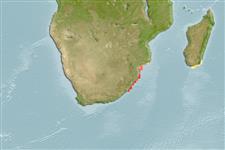Classification / Names
ຊື່ສາມັນ | ຄຳສັບຄ້າຍຄືກັນ | Catalog of Fishes(ຕະກຸນ, ຊະນິດ) | ITIS | CoL | WoRMS | Cloffa
>
Eupercaria/misc (Various families in series Eupercaria) >
Labridae (Wrasses) > Corinae
Etymology: Halichoeres: Greek, als, alis = salt + Greek, choiros = pig (Ref. 45335); zulu: Named for the indigenous people of the Province of Kwazulu-Natal, South Africa..
More on authors: Randall & King.
Environment: milieu / climate zone / depth range / distribution range
ນິເວດວິທະຍາ
ສັດທະເລ ກ່ຽວກັນຫີນ; ລະດັບຄວາມເລິກ 0 - 2 m (Ref. 83900). Subtropical
Western Indian Ocean: South Africa.
ຂະໜາດ / ນ້ຳໜັກ / Age
Maturity: Lm ? range ? - ? cm
Max length : 13.5 cm SL ຕົວຜູ້/ບໍ່ມີເພດ; (Ref. 83900); 7.9 cm SL (female)
Short description
ສະລີລະວິທະຍາ | ການວັດແທກຮູບຮ່າງລັກສະນະພາຍນອກຂອງດິນ,ສັດ,ປາ…
ຄີ (ໜາມ)ແຂງຢູ່ຫຼັງປາ (ທັງໝົດ): 9; ຄີຫຼັງຂອງປາ (ຄີອ່ອນ) (ທັງໝົດ): 11; ຄີ(ໜາມ) ແຂງຢູ່ຄີກົ້ນປາ
ກຸ່ມປາກະດູກແຂງ
ຄວາມຖີ່ຂອງກຸ່ມຖ່າຍທອດພັນ
ປາທີ່ມີການເຄື່ອນຍ້າຍຈາກທະເລໄປຫານ້ຳຈືດ ແລະນ້ຳຈືດຫາທະເລ
ປາທີ່ມີການເຄື່ອນຍ້າຍຈາກທະເລແລະໄປໄຂ່ຢູ່ນ້ຳຈືດ
ຄີກົ້ນຂອງປາ
ສັດທີ່ມີກະດູກສັນຫັຼງ
ການຖ່າຍທອດທາງກຳມະພັນຈາກພໍ່ແມ່ຫາລູກ 3; ຄີກົ້ນຂອງປາ: 11. This species is characterized by the following: D IX,11; A III,11; pectoral rays 14 (rarely 13); 26 lateral line scales; naked head with no small scales on opercle or behind eye; narrow median dorsal zone of nape naked; 7 prepelvic scales, anterior third of chest naked; 3-5 tubule branches on lateral line scales; 11-15 suborbital pores; 19-21 gill rakers; body depth 2.95-3.6 in SL; caudal fin slightly rounded, 1.4-1.45 in HL; preserved color of female pale tan, the scales on upper two-thirds of body, posterior to pectoral fins, with brown centers, those below soft portion of dorsal fin and in lowermost row dark brown; 3 broad dusky bars on chest and abdomen, fading ventrally; opercular flap at upper end of gill opening with a black spot shaped like an inverted comma; usually present behind upper part of orbit is a dark brown spot of near-pupil size; snout with an oblique dusky band; across cheek and opercle is an elongated, dark-edged, horseshoe-shaped band; oblique brown bands on dorsal fin with a small black spot on first membrane and an ocellated black spot between second and fourth dorsal soft rays; small dark spots on caudal fin rays; similar basic color pattern in male, but most markings are darker; no black spot anteriorly on dorsal fin and no oblique bands in spinous portion; base of anal fin with a wavy dark band and a pale spot at base of each membrane. In life, females are mainly pink or lavender-pink, with narrow pale green bands, a bright red stripe on nape, extending below base of spinous portion of dorsal fin, a row of small dark brown spots on side of body above anal fin; males with deep pink and bright green bands on head, with alternating wavy stripes of bright green and purplish red on body (Ref. 83900).
A rare species with paucity of specimens, this is partly due to its misidentification as Halichoeres nebulosus, its usual shallow-water habitat off exposed rocky shores where it is difficult to collect and its being very elusive. Found on rocky bottom or sand with scattered patches of reef at depths of 0.5-1.5 meters. A male individual was photographed from a pool (about 5 m long, 2 m wide and 1.2 m deep) almost close to the sea at low tide (Ref. 83900).
Life cycle and mating behavior
ການຈະເລີນເຕັມໄວ | ການສືບພັນ | ການວາງໄຂ່ | ໄຂ່ | ຄວາມດົກຂອງໄຂ່ປາ | ຕົວອ່ອນ
Distinct pairing during breeding (Ref. 205).
Randall, J.E. and D.R. King, 2010. Halichoeres zulu, a new labrid fish from South Africa. Smithiana Bull. 11:17-23. (Ref. 83900)
IUCN Red List Status (Ref. 130435)
Threat to humans
Harmless
Human uses
ຂໍ້ມູນຕື່ມອີກ
ຊື່ສາມັນຄຳສັບຄ້າຍຄືກັນການເຜົາໃໝ້ພະລັງງານໂດຍປ່ຽນທາດອາຫານໃນຮ່າງກາຍໃຫ້ກາຍເປັນຊີ້ນແລະໜັງຜູ້ລ້າການສຶກສາຜົນກະທົບຂອງສານຜິດທີ່ມີຜົນກະທົບຕໍ່ລະບົບນິເວດການສືບພັນການຈະເລີນເຕັມໄວການວາງໄຂ່ການສັງລວມການວາງໄຂ່ຄວາມດົກຂອງໄຂ່ປາໄຂ່Egg development
Age/Sizeການເຕີບໃຫຍ່Length-weightLength-lengthLength-frequenciesການວັດແທກຮູບຮ່າງລັກສະນະພາຍນອກຂອງດິນ,ສັດ,ປາ…ສະລີລະວິທະຍາຕົວອ່ອນການປ່ຽນແປງຂອງຕົວອ່ອນການທົດແທນທີ່ຄວາມອຸດົມສົມບູນBRUVS
ເອກະສານອ້າງອີງການລ້ຽງສັດນ້ຳຂໍ້ມູນການລ້ຽງສັດນ້ຳສາຍພັນກຳມະພັນElectrophoresesການຖ່າຍທອດທາງກຳມະພັນຈາກພໍ່ແມ່ຫາລູກພະຍາດການປຸງແຕ່ງNutrientsMass conversion
ຜູ້ຮ່ວມມືຮູບStamps, Coins Misc.ສຽງຫອຍມີພິດຊະນິດນຶ່ງທີ່ອາໄສໃນທະເລຄວາມໄວປະເພດການລອຍເນື້ອທີ່ເຫືອກOtolithsສະໝອງວິໄສທັດ
ເຄື່ອງມື
Special reports
Download XML
ແຫຼ່ງອີນເຕີເນັດ
Estimates based on models
Preferred temperature (Ref.
123201): 23.6 - 25.4, mean 24.9 °C (based on 27 cells).
Phylogenetic diversity index (Ref.
82804): PD
50 = 0.5000 [Uniqueness, from 0.5 = low to 2.0 = high].
Bayesian length-weight: a=0.00955 (0.00451 - 0.02020), b=3.09 (2.92 - 3.26), in cm total length, based on LWR estimates for this Genus-body shape (Ref.
93245).
ຊັ້ນເຂດຮ້ອນ (Ref.
69278): 3.5 ±0.5 se; based on size and trophs of closest relatives
ຄວາມຢືດຢຸ່ນ (Ref.
120179): ສູງ, ປະຊາກອນຕຳ່ສຸດທີ່ໃຊ້ເວລາສອງໜ້ອຍກວ່າ 15 ເດືອນ (Preliminary K or Fecundity.).
Fishing Vulnerability (Ref.
59153): Low vulnerability (10 of 100).
